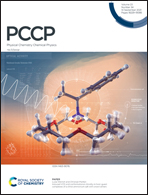Crown ethers in hydrogenated graphene†
Abstract
Crown ethers could serve as hosts to selectively incorporate various guest atoms or molecules within the macrocycles. However, the high flexibility of crown ether molecules limits their applications in areas requiring a higher binding strength and selectivity. As an important graphene derivate, graphane, which is composed of entirely sp3 hybridized carbon atoms and possesses the characteristic of non-wrinkle in contrast to graphene, provides an ideal two-dimensional platform to rigidify crown ether molecules. In this work, using first principles calculations, we demonstrate that the embedment of various crown ethers with different cavity sizes in the graphane lattice are thermodynamically and kinetically stable. Compared with the corresponding crown ether molecules, the binding strength for alkali metal cations can be increased by up to ∼14 times, which may provide a good means in the field of alkali metal cation separation. Meanwhile, the electronic properties of graphane could be tuned in a range of 4.43–5.85 eV by controlling the densities of the crown ethers. These crown ether graphanes are also good candidates for the photolysis of water. Therefore, considering the easy synthesis and tunable crystal structures of graphane, we expect that our findings will trigger a new wave of research and applications of both crown ethers and graphane.



 Please wait while we load your content...
Please wait while we load your content...